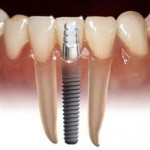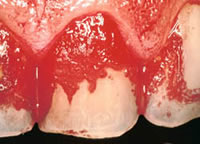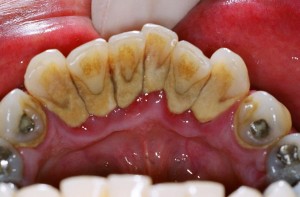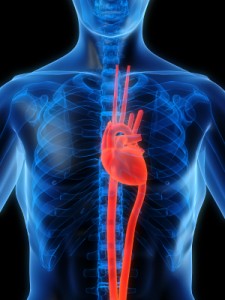Pemphigus vulgaris is an autoimmune or “self-allergy” disease in which a patient’s own circulating antibodies become altered so that they attack the points of adhesion of the epithelial cells, one to another, of the skin and mucous membranes. Women are more frequently affected than men and the disease is usually diagnosed between the ages of 50-70 years, often with oral blisters as the first sign. Children are rarely affected. The typical lesion is a small or large, clear-fluid blister which breaks rapidly in the mouth to leave a flat white, somewhat tender ulcer with a thin red line around it. Skin blisters may last for hours or days, and blisters may be caused by pressure on the skin or membranes of the mouth. There is no cure, but pemphigus is treated with heavy doses of corticosteroids and azathioprine, with frequent relapses after the therapy is stopped. Secondary infection is common because of the immune system suppression from these drugs. The overall mortality is less than 6%, usually from infection or loss of body fluid from a large number of blisters. Continue reading
Dental care for osteogenesis imperfecta patients Part 3
Other Treatments
Dental Implants are used to replace missing teeth. Theoretically it is possible to do this successfully for a person with OI and there is anecdotal evidence that this has been accomplished. However, there are no controlled studies on the use of dental implants in people with OI and only a few case reports in the literature. The high failure, reported to be 50 per cent within 3 years of surgery is a concern.
Dental implants are somewhat like screws. In order to function, there must be enough bone in the jaw for the implant to be securely placed. After healing, a “post†is placed in the implant and an artificial tooth is attached. Good, strong healing around the implant is critical. Continue reading
Dental care for osteogenesis imperfecta patients Part 2
General Care for People With OI Plus DI
Children with OI and dentinogenesis imperfecta need the same basic care as discussed in Part 1, but they also need to be monitored for cracking, chipping and abrasion of the teeth. Special care will be needed even with the baby teeth. All of the teeth may not be affected by DI, and primary teeth usually are affected to a greater extent than the permanent teeth. Restorative treatment may be needed at some point. Continue reading
Abscess Tooth Symptoms
What is an Abscessed Tooth?
A tooth or dental abscess is a localized collection of pus in a sac formed by disintegration of purulent material from a bacterial infection. Invasion of bacteria which cannot be drained results in abscess. An abscessed tooth can be further classified into periapical, periodontal or gingival abscess depending on its location in the oral cavity.
- Periapical abscess: located at the apex of an infected tooth surrounding the roots. Continue reading
Dental care for osteogenesis imperfecta patients Part 1
Osteogenesis imperfecta (OI) is always associated with bone fragility. In addition, OI may affect the growth of the jaws and may or may not affect the teeth. About half of the people who have OI have teeth that appear normal, and their major concerns are routine care. However, the other half has a defect in the teeth called dentinogenesis imperfecta (DI), sometimes referred to as opalescent teeth or brittle teeth. These teeth may be misshapen, may chip or break easily, and will require special care. Continue reading
Is Dental Plaque the Main Cause of Dental Caries?
Our mouth is constantly bathed in saliva and is exposed to the passage of food, the oral flora and many other stimuli considering the variety of objects that people put in their mouths such as cigarettes, pipes, hair-grips and so on. Nevertheless, our mouth has a remarkable ability to resist and adapt according to these stimulations. Our teeth are also exposed to the same factors and they can be covered wholly or in part by food debris, soft and hard deposits.
Â
Dental Plaque, the main cause of Dental Caries
Dental Plaque is a soft but adherent deposit of bacteria and their products, which forms on all tooth surfaces and other objects in the mouth, for example; fillings or dentures. This Plaque formation is a natural, physiological process and is an example of a biofilm, which means it is not a haphazard collection of bacteria but a complex association of many different bacterial species living together in a single environment. For instance, a newborn baby’s mouth is sterile but within a few hours, microorganisms appear; mainly Streptococcus salivarius. By the time the baby had his/ her first tooth out, a complex flora is established.
Â
Basically, Dental Plaque is scarcely visible in thin layers and it can be revealed only by the use of a Plaque-Disclosing Agent. In thick layers, it can be seen as yellowish or grey deposits which cannot be removed with mouthwashes or by irrigation but can be brushed off. It is usual to find it on areas which are difficult to reach by tooth brushing, for example; in between teeth or in severely crowded teeth. When Dental Plaque calcified or mineralized, it will become Dental Calculus or commonly known as Tartar. It is a ‘stony crust’ that forms on teeth and has long been associated with Gums Disease. Having said that; Dental Plaque is the main cause of dental caries.
Â
Â
     Â
Â
Â
Â
      Â
    Â
Â
Â
Â
Continue reading
How Aging Affects Our Mouth
Aging is a normal life process, which is subtle and is characterized by individual variation in onset and rate of decline. The basis of this process lies in changes in various macromolecules (from D.N.A. to membrane proteins) which primarily lead to alteration the form of function of a tissue or organ as a result of biological activity associated with a minor disturbance of normal cellular turnover. Continue reading
Dental osteomyelitis
Dental osteomyelitis (or osteomyelitis of the jawbone) is an acute or chronic jawbone infection, usually caused by bacteria. It is extremely difficult to diagnose and treat. Continue reading
Biophosphate induced oeteoradionecrosis
Bisphosphonate-related osteonecrosis of the jaw (BRONJ) is a condition found in patients who have received intravenous and oral forms of bisphosphonate therapy for various bone-related conditions. Bisphosphonate-related osteonecrosis of the jaw (BRONJ) manifests as exposed, nonvital bone involving the maxillofacial structures. Bisphosphonate-related osteonecrosis of the jaw (BRONJ) is thought to be caused by trauma to dentoalveolar structures that have a limited capacity for bone healing due to the effects of bisphosphonate therapy. Continue reading
Do I need Antibiotic Cover before Dental Treatment? Part 2
Continued from Part 1
The new guidelines are aimed at individuals who would have the greatest risk of a bad outcome if they developed a heart infection.
Antibiotics cover prior to a dental procedure is advised for individuals with: Continue reading




